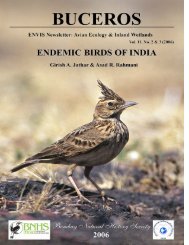Untitled - ENVIS Centre on Avian Ecology
Untitled - ENVIS Centre on Avian Ecology
Untitled - ENVIS Centre on Avian Ecology
You also want an ePaper? Increase the reach of your titles
YUMPU automatically turns print PDFs into web optimized ePapers that Google loves.
VULNERABLE<br />
THREATENED BIRDS OF INDIA<br />
Buceros Vol. 7 & No. 1 & 2 (2002)<br />
knowledge of the pressures <strong>on</strong> the forests it inhabits is<br />
equally scant. A threat comm<strong>on</strong> to all forest birds in northeast<br />
India, however, is the widespread damage to habitat<br />
caused by semi-shifting cultivati<strong>on</strong> or “jhum”; although<br />
this practice has encouraged bamboo growth it has caused<br />
widespread loss of forest except in steep inaccessible areas<br />
where cultivati<strong>on</strong> is difficult 8 . Habitat in the Shill<strong>on</strong>g-<br />
Cherra-Mawphlang area of the Khasia hills was recently<br />
described as a mosaic of cultivati<strong>on</strong> and patches of<br />
broadleaved evergreen forest (sometimes mixed with<br />
pine), but with habitat covering the ridge above Shill<strong>on</strong>g<br />
being in particularly good c<strong>on</strong>diti<strong>on</strong> (C. R. Robs<strong>on</strong> in<br />
litt. 2001). Elsewhere in the area remaining forest was<br />
either c<strong>on</strong>fined to low-stature (perhaps sec<strong>on</strong>dary) locally<br />
protected (sacred) groves or restricted to very steep<br />
58<br />
inaccessible slopes 5 .<br />
C<strong>on</strong>servati<strong>on</strong> measures: N<strong>on</strong>e is known apart from the<br />
existence of locally protected sacred groves (including<br />
Mawphlang) that might provide important protecti<strong>on</strong> for<br />
the species 5 .<br />
References: 1. Ali and Ripley 1978–1999; 2. Grimmett<br />
et al. 1998; 3. Baker 1894–1901; 4. Grimmett 1979; 5.<br />
BirdLife Internati<strong>on</strong>al 2001; 6. Baker 1922–1930; 7.<br />
Stattersfield et al. 1998; 8. Choudhury 1992.<br />
Tawny-breasted Wren-babbler in some of the IBAs<br />
Assam: 1.Jatinga, 2. Barail range and North Cachar RF;<br />
Mizoram: Murlen NP.<br />
n n n<br />
SNOWY-THROATED BABBLER Stachyris oglei Vulnerable B1+2a,b,c,d,e; C1<br />
This species is inferred to have a small, severely fragmented, declining range and<br />
populati<strong>on</strong> because of loss of scrub and forest to logging and shifting cultivati<strong>on</strong>.<br />
These factors qualify it as Vulnerable.<br />
Distributi<strong>on</strong>: The Snowy-throated Babbler occupies an<br />
extremely restricted range in the forested hills of northeastern<br />
India and extreme northern Myanmar.<br />
In India the species is a rare resident with a restricted<br />
range, apparently c<strong>on</strong>fined to eastern Arunachal Pradesh 1 .<br />
Although many specimens are listed from “Margherita”,<br />
Assam 2 , it is likely that these are all from above this town<br />
in the Naga/Patkai range, and thus near Tirap in Arunachal<br />
Pradesh 3 .<br />
Populati<strong>on</strong>: The tiny global range of this species suggests<br />
that overall numbers are low. It has always been thought<br />
very rare 1,4 . Recently it has been found in good numbers<br />
in Namdapha Nati<strong>on</strong>al Park: 20–25 individuals were seen<br />
al<strong>on</strong>g a few kilometres of road from Deban to<br />
Vijaynagar 5 , and around 20 were seen daily around<br />
Embe<strong>on</strong>g 6 .<br />
that are entirely restricted to the “Eastern Himalayas<br />
Endemic Bird Area”, threats and c<strong>on</strong>servati<strong>on</strong> measures<br />
are profiled 7 . As there are still fairly large areas of<br />
unsurveyed forest in its restricted range the species is<br />
probably not in immediate danger. However, these<br />
circumstances may change and pressures <strong>on</strong> the regi<strong>on</strong>’s<br />
habitat appear to be increasing.<br />
C<strong>on</strong>servati<strong>on</strong> measures: In India the species occurs in<br />
Namdapha Nati<strong>on</strong>al Park and may well be found in<br />
nearby Kamlang Wildlife Sanctuary.<br />
References: 1. Ali and Ripley 1978-1999; 2. Stevens<br />
1914-1915; 3. Choudhury 2000; 4. Haringt<strong>on</strong> 1914–1915;<br />
5. Alström et al. 1994; 6. Hornbuckle 1998b; 7.<br />
Stattersfield et al. 1998<br />
Main threats: The Snowy-throated Babbler is <strong>on</strong>e of<br />
Snowy-throated Babbler in some of the IBAs<br />
Arunachal Pradesh: 1. Namdapha and Kamalang WLS;<br />
Assam: Upper Dihing (East block) - Kakojan RF, West<br />
nine threatened members of the suite of 19 bird species Bengal: Gorumara NP<br />
n n n<br />
JERDON’S BABBLER Chrysomma altirostre Vulnerable A1c; A2c; C1<br />
This species’s small populati<strong>on</strong> is inferred to be rapidly declining as a result of extensive loss of its<br />
tall, wet grassland habitat, primarily due to drainage and c<strong>on</strong>versi<strong>on</strong> to cultivati<strong>on</strong>. It therefore<br />
qualifies as Vulnerable.<br />
Distributi<strong>on</strong>: Jerd<strong>on</strong>’s Babbler occurs in the Indus valley<br />
of Pakistan, the plains and Brahmaputra valley of north-<br />
east India, and the terai of Nepal, historically from Myanmar<br />
and possibly from Bangladesh. There are three disjunct




